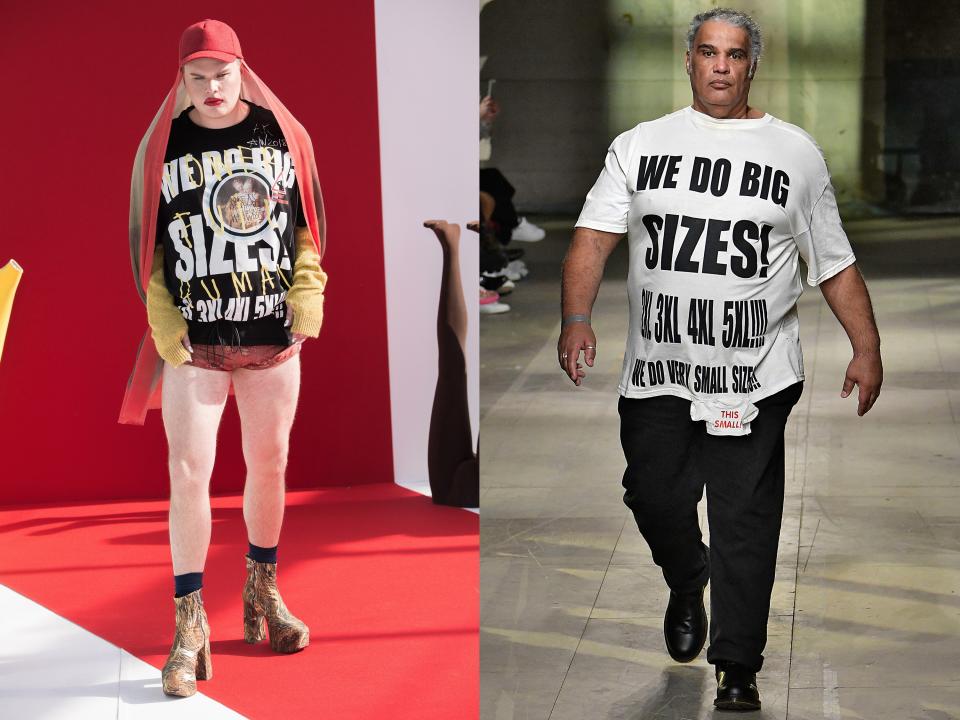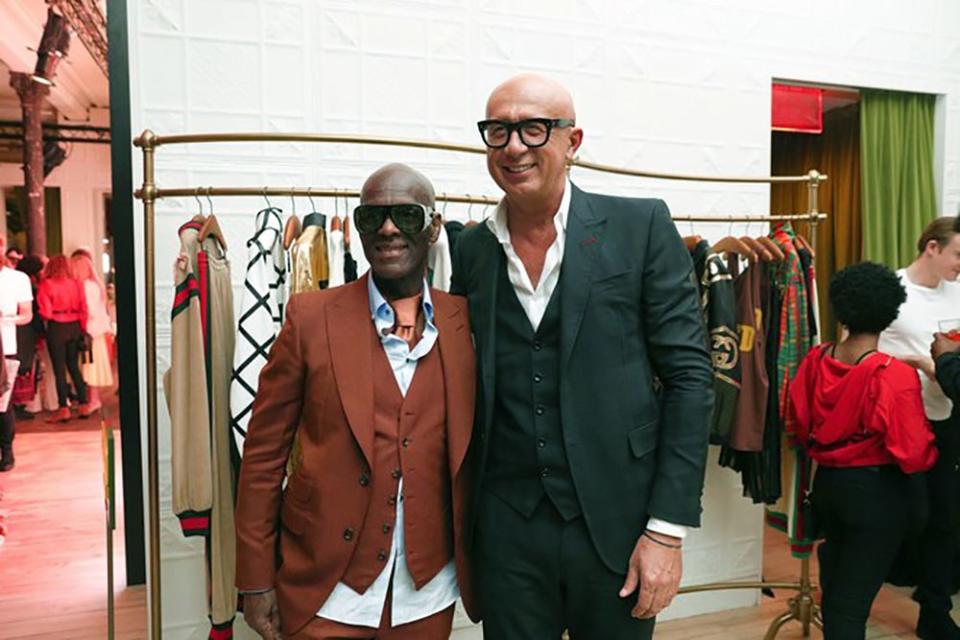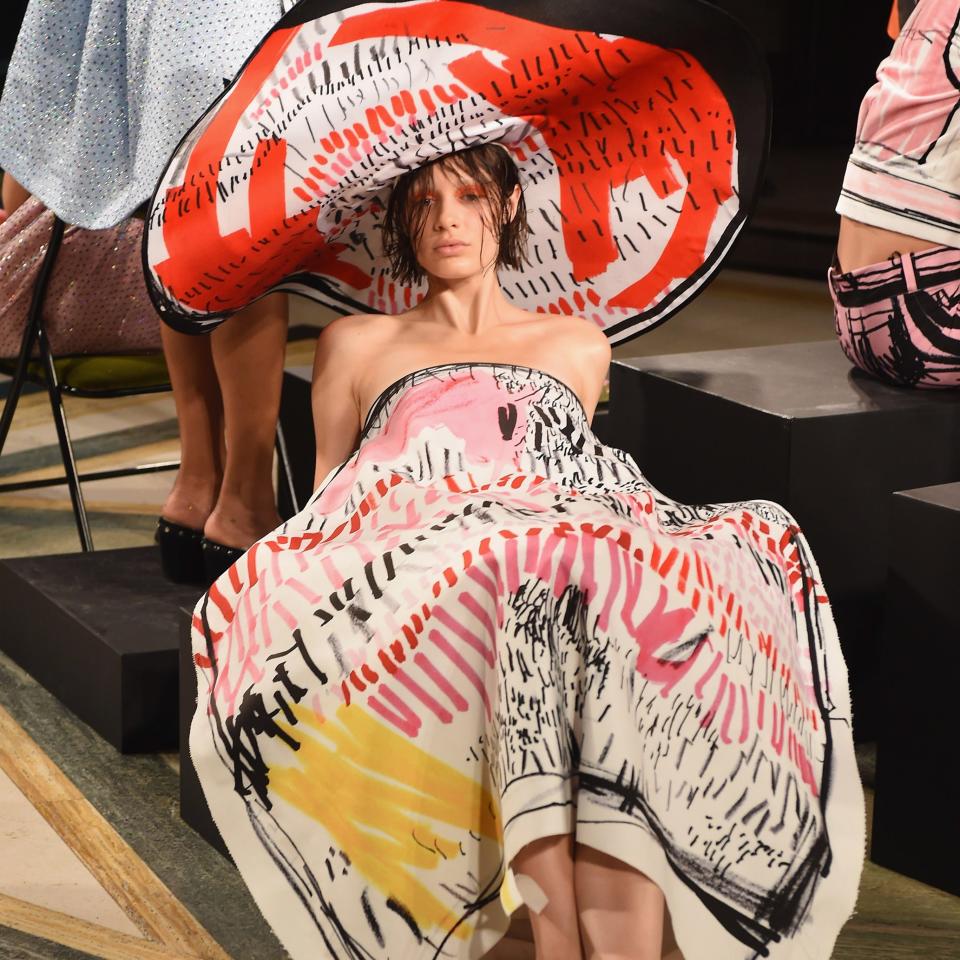How Can Fashion Students and Aspiring Designers Safeguard Their Work? Sarah Mower Asked the Experts
We’ve heard about safeguarding models, factory workers, and employees in the vast, nebulously interconnected fields of fashion. Now: What about the rights of young designers? For the last two months, I’ve taken a walk in the be-fogged borderlands through which fashion design newcomers must tread as they eagerly seek job interviews, pitch for freelance contracts, and go for all kinds of casual, whatnot meet-ups. How can they protect their graduate collections, sketchbooks, and everything they’ve put on Instagram from being copied?
Since a she said, he said involving the young Norwegian designer Edda Gimnes and the Spring 2019 Moschino show blew up—just one of many, many bones of contention picked over by the internet—I’ve been taking time to ask lawyers, academics, headhunters, and fashion industry consultants how the legal land really lies for any small individual. The short answer: It’s a minefield hidden in a quagmire. No matter how vociferously designers’ supporters leave comments to “Sue!” it’s naive to think that can just happen. “The biggest issue that young designers face is not having access to the cash to enforce the rights that they might have,” says Hugh Devlin, a consultant in luxury fashion at law firm Withers LLP in London.
Closing the recent uproar on her Instagram feed, Edda Gimnes wrote, “For the time being, I will not waste my time nor my energy on this matter. Instead, I will continue to work as passionately and as hard as ever before and aim even higher.” (Friends who knew her exuberant hand-scribble printed collections had spotted what they saw as similarities with the sketch-process inspiration of the Moschino show—and almost 27,000 commented. Jeremy Scott responded with photographs of Moschino and Moschino Cheap & Chic references going back to 1992 on his Instagram Stories feed.) A couple of months on, Gimnes has another collection herself, and is moving forward.
But she does offer a general observation about what she learned from the experience: “I had thousands of messages, many from people who said, ‘this has happened to me.’ I feel this happens all the time. There should be a law to protect fashion graduates, young designers, artists.” The thing is, there are laws protecting intellectual property (different, depending on each territory). But the depressingly familiar broad-brush consensus of every expert I spoke with is that the law only defends those who can afford to use it. Just like young people bringing claims of discrimination and sexual crimes against the powerful and deep-pocketed, poor, in-debt fashion graduates, who are also fearful of getting a bad industry reputation, are not likely to succeed in going legal.

Julie Zerbo’s website The Fashion Law, provides a stunning window onto the hyper-litigious habits of big fashion brands bringing million-dollar suits against each other. At a high level, they’re at it all the time: A tiny selection of posts covers such excitements as Puma v Forever 21, Halston v Calvin Klein, Converse v dozens of shoe sellers including New Balance, Skechers, and Fila (“One of the most hotly-litigated trademark cases ever”), and CAR-FRESHNER v Balenciaga. But what of newcomers’ chances of remedy?
“Practically speaking, the odds are against them at the outset because legal action is expensive. Simply hiring a lawyer to draft a cease and desist letter (though that is not required, as anyone can legally draft such a letter) can be costly and that is only the beginning, usually the very first step,” Zerbo advised in an email. “Big brands, many of which have legal teams in-house, will always have more resources to devote, including fighting back against a lawsuit (or threat of a lawsuit), and should they choose to, taking the case all the way to trial. Even when young designers can file suit, it’s not uncommon to hear (in and out of the fashion industry) of the larger party’s counsel strategically litigating in a way to make it more expensive for the other party, thereby ‘litigating (the other brand) to death,’ so to speak.”
That seems hopeless, and scary. But then again, now there’s a new blunt-force weapon in the field: the calling-out of copying on social media. “It’s become its own #MeToo campaign,” comments Mary Gallagher, a headhunter in Paris with the firm Martens & Head who finds and places designers in the luxury market. “It’s been going on and on. I’ve heard about it for years, first as an editor, then as a buyer, and now as a headhunter: the designer going to interview, having their book whipped away, hearing the photocopier whirring in the back office—and then not getting the job, but seeing their ideas later on the catwalk. People only used to be able to cry to a few friends. But now, social media has become the watchdog.” Thanks to feeds like Diet Prada’s “Ppl knocking each other off lol,” scanning for similarities between fashion products has practically become mass entertainment, a tit-for-tat that might make a political studies PhD for someone who could stand back and weigh it all on the scales of current public anxiety-slash-disinterest in the fake versus the genuine.
Everyone—former gatekeepers to the fashion system, included—acknowledges that social media has changed everything. Sara Kozlowski, Director of Education and Professional Development at the CFDA, observes that, “While there are a number of firms specializing in fashion law, it can be really hard to evidence cases, and there is still limited regulation. But what we’ve observed is that sometimes designers have faster, greater success taking to social media, calling out copying on their own channels. Instagram can be a powerful platform. The exposure combined with ‘cease and desist’ letters has been known to get results.”

There’s been at least one famously happy outcome from an internet outcry: Gucci transformed criticism about its appropriation of a Dapper Dan design into a coup when it went into partnership with the designer, whose real name is Daniel Day, backing the opening of his new Harlem atelier in March of this year. In today’s Internet-driven world, social media pressure can affect change, even if what has transpired is not technically illegal. Indeed, the boards of publicly-traded companies are obliged to consider the impact of reputational damage as a risk to shareholder value. Burberry’s announcement that it will stop burning unsold stock is another example, again in 2018.
In an era when so many brands are desperate to win the love and loyalty of Gen Z-ers and Millennials, the importance of having clean hands—environmentally, ethically, and design-wise—is increasingly part of maintaining a sparkling corporate image. That said, it makes no sense that the fashion court of social media should be the be-all and end-all. Trolls and people willing to throw around poorly researched remarks and jump to way off base judgments are as commonplace as anywhere else.
As someone who visits universities and discovers and mentors talented people, I’m interested specifically in how complete newcomers can say something new and personal—and then use it to start earning, in jobs, under contract, independently, whatever. I’ve found young designers from all over the world through Instagram, which has fast become the standard medium for showing all you’ve got in public. The mystique of the silent, hidden talent saving up their special fashion genius for private viewing has been swept away in the competition to self-promote. At graduation, when you’ve only got your hard-earned ideas to sell, should all this sharing really be that indiscriminate? People can steal a young designer’s work without ever meeting them at all.
Before anyone runs away with the idea that all graduate ideas are original, I can vouch for the fact that—just like many unexciting standard-fare collections we see from brands—they’re not. Plenty of students emerge apparently unaware that they’re designing in the style of something done long ago, or that their collections are a mere watery mishmash of current fashion. Youth notwithstanding, young designers should be certain to know their fashion history. The mark of talent is being able to select and handle quotes consciously, and to frame them in a new way which sparks a fresh collision of delight and shock. There’s a world of difference between that and regurgitation.
It’s a super-complicated two-way dynamic for people who’ve grown up living online, according to the fashion educators who are trying to arm them with survival tools to thrive in this new world of digital sharing. Fabio Piras, course director of Central Saint Martins’s famed fashion MA degree, believes “it’s a matter of being able to understand boundaries for them, and for those who deal with them. It’s not okay to take someone’s ideas without giving them credit for it. We’re in a mash-up world, a context made of endless reference and collage-like thinking.” The school has an annual post-graduation open house day for industry professionals to view student collections. These days, Piras puts up a warning sign on the wall for visitors: “No photographs, please.”
Simon Ungless, Director of Fashion at San Francisco’s Academy of Art University sees eye to eye with that. “We have to be responsible to teach these young creatives their own and their work’s worth. Idea generation is incredibly valuable, and we all know that most of the time, new ideas come from youth. I meet young designers all the time who haven’t got a clue how to operate themselves commercially. They don’t know how much a design is worth, how to negotiate, or even how to write an invoice. They’re more than savvy on how to ‘build a brand’ on social media, but past that, they hardly have a clue.”
In other words, kids today are still young—and need to learn self-protection measures tailored to a situation in which swaths of the industry outside are racing ever more quickly and voraciously. “They are encouraged to show everything and not hold back. They need the knowledge of their value in order to wield a little power. Also, students see that it is ok to copy/rip off/remake/be inspired by other designers,” Ungless adds. “We are seeing this constantly these days and see designers being awarded for it.”
In a climate where design studio pressure to be inspired is so enormous, the temptation to simply replicate something you’ve happened to see might be too much. Or maybe (as academics worry) it’s just toxic new-normal behavior in a hyper-stressed design industry. “It’s the pace of the industry. Designers are under so much pressure—first, it was two collections a year, then four with pre-collections, and now it’s drops, coming up with something new every few weeks,” reasons Julie Gilhart, a champion of young designers. “So they’re spent for ideas. You can see why it happens.”
All this said, there are voices being raised that there should be better safeguards for designers at the very beginning of their careers. “There needs to be some sort of legalized system,” says Gilhart. “In the tech industry, it’s normal for someone who has an idea for a startup to go into an investor meeting with an NDA. Why should there not be one for designers showing their portfolios?”
There’s also the practice of headhunters, honed over years. In this day and age of direct messaging, it might be forgotten that agencies like Martens & Head offer professional buffer zones between candidate and client. Mary Gallagher says they represent by holding back. “We only send the client a taster of the designer’s book, not the whole. And then it’s important that the designer meets with them personally.” Her agency places top designers—worth a lot in terms of salary. But she passes on a golden rule for beginners: “Never leave your book with them. Don’t do it. Just say something like, ‘It’s just my principles.’”
After a show—even on a school graduation runway—designers can be assured that a portion of their work is already out, circulating in the world. If something pops up later on another designer’s runway which seems suspiciously similar, there’s always the social media shaming option, but you need to take care with it. “Sometimes, taking to social media to shame a house is the most effective way to get some sort of payback. That said, designers taking to social media need to be very careful about how they phrase an accusation,” says Hugh Devlin. “Coincidences happen and accusation could be costly for the person who feels aggrieved.”
The Fashion Law’s Julie Zerbo warns: “I tend to really caution brands about engaging in call-outs online without first consulting with a lawyer. While some instances have resulted in some positive outcomes, there have also been instances when the brand that has been called out turns around and threatens to sue for defamation. It’s critical that designers are careful about that. A lot of lawyers do pro bono work every year, which can be helpful for young designers. Volunteer Lawyers for the Arts devote themselves to assisting low-income creatives.”
In conclusion? Even if you never earn a penny in compensation after feeling you’ve been plagiarized, with a little knowledge of how to spin the situation, you might possibly end up a little better off for having your work spotlight by public discussion. The best way to benefit, in the end, is to be resilient and come up with something new. That, after all, is the job of a fashion designer. As the late and legendary Professor Louise Wilson used to say to students who’d completed their collections, “And have you got another idea?”
Still, after all these conversations, and all of this advice, I’m left with an uncomfortable feeling. The thing that really needs to happen is not for clueless young designers to learn more about how to conduct themselves in front of potential employers, that would be the equivalent of people cajoling women not to dress a certain way because it might provoke a sexual assault. The change needs to be the other way around. Isn’t it high time for more honor and respect in the system, from HR, creative directors, CEOs, and board members alike? Meanwhile, if novel ideas are so desperately needed, and creative directors so stressed by the pressure to excite Gen Z, doesn’t it just make straightforward commercial sense for brands to bring in more work from young people, to hire them as consultants? It would surely help make this world of fashion a fairer, less murky, and far more interesting place. Just pay.


